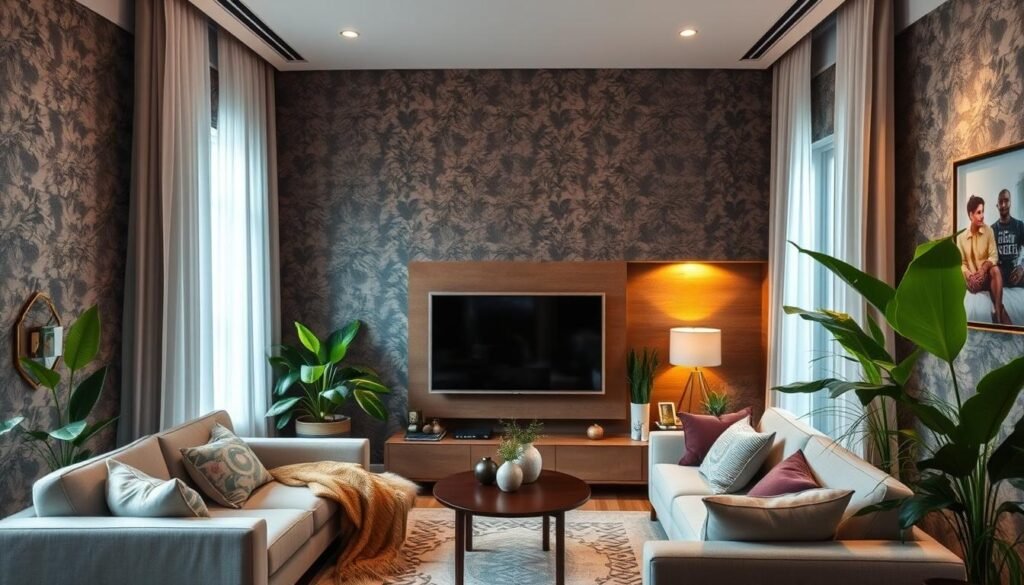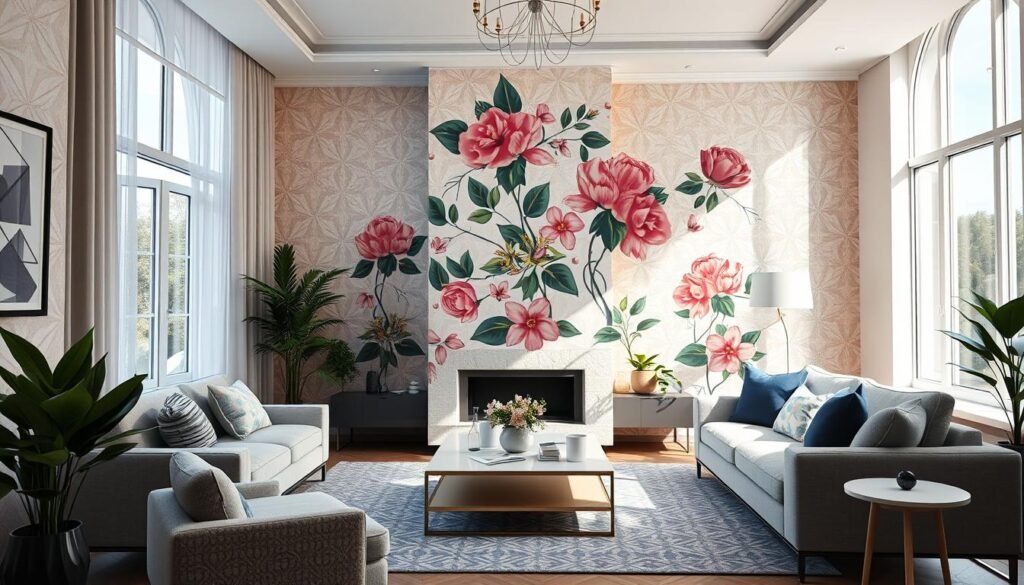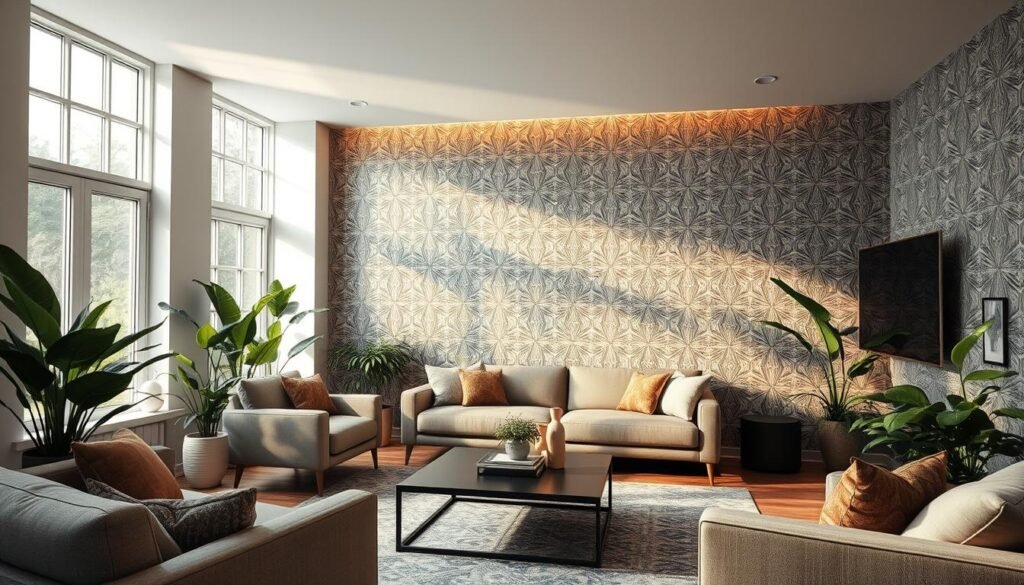Changing your home starts with picking the right wallpaper & feature walls. They should match your style and make your decor better. With so many choices, you can make any room more interesting and lively.
Feature walls are now more than just eye-catching. They’re also a smart way to make your home look better without spending a lot. Wallpaper designs are getting more popular, offering themes like calm blues and bright yellows. Each choice helps make your home renovation special.
Key Takeaways
- Feature wallpaper can dramatically transform ordinary rooms into memorable spaces.
- Using wallpaper in business designs increases customer engagement, creating a lasting impression.
- There is a wide variety of feature wallpaper available to suit different environments such as nurseries and offices.
- Modern wallpapers are durable and easy to clean, suitable for high-traffic areas.
- Personalised wallpaper options lead to unique designs that reflect your personality.
- Accent walls attract attention, enhancing the overall aesthetic of any space.
Understanding Wallpaper Styles and Types
Choosing the right wallpaper for your home is key. The world of wallpaper is vast, with many styles and types to choose from. Whether you prefer traditional patterns or modern designs, and even eco-friendly options, there’s something for everyone.
Traditional vs. Modern Wallpaper
Traditional wallpaper designs often include classic motifs like florals and damasks. These patterns add elegance to dining areas and living rooms. Modern wallpaper, on the other hand, features bold colours and graphic prints. Geometric patterns and large-scale designs are popular, making a statement in home offices or bedrooms.
Textured Wallpaper Options
Textured wallpaper brings depth and interest to walls. It offers a tactile experience that plain finishes can’t match. Flock or embossed wallpapers are luxurious, perfect for bedrooms. Textured wallpapers can also add a rustic charm to your home, warming up any room.
Eco-Friendly Wallpaper Choices
Eco-friendly wallpaper is becoming more popular as people focus on sustainable home design. Grasscloth, made from plant fibres, is a great choice for low-humidity areas. Peel and stick options, often made of vinyl, are durable and easy to use. Opting for eco-friendly wallpaper not only beautifies your home but also supports sustainable living.
Choosing the Right Feature Wall for Your Space
Creating a stunning feature wall can transform your space. Knowing the key factors in feature wall design helps you make the right choices. Think about the room’s function, furniture, and architectural features to enhance your accent wall’s impact.
Factors to Consider in Feature Wall Design
When picking a feature wall, consider these factors:
- Room Size: Accent walls look best in bright, open spaces. They can make small rooms feel cramped.
- Focal Points: Place walls with existing focal points, like fireplaces or artwork, for maximum impact.
- Color Coordination: Feature wall colours should match the decor. Light to medium shades help keep balance.
Popular Locations for Feature Walls
Various spaces are suited for different accent wall locations. Here are some popular spots:
- Living Rooms: Often feature bold patterns or colours as a statement piece.
- Bedrooms: Behind the bed is a favourite for a stylish, serene look.
- Dining Areas: Accent walls can enhance the dining experience, in larger rooms.
- Bathrooms and Kitchens: Becoming popular for adding personality or elegance.
- Hallways and Home Offices: These areas benefit from a visual focal point, making them more inviting and functional.
Tips for Selecting the Right Colour
Choosing the right colour for your feature wall greatly affects the room’s atmosphere. Here are some tips:
- Light Hues: Light colours make rooms appear larger, enhancing openness.
- Dark Colours: These draw attention but can absorb light, affecting brightness.
- Test Samples: Always test paint chips or wallpaper samples on the wall to see how they interact with room light throughout the day.
- Cohesion: Pick colours that reflect your existing decor to maintain a cohesive design story.
Benefits of Using Wallpaper in Your Home
Adding wallpaper to your home renovation brings many benefits. It makes your space more inviting and solves practical problems. Knowing these benefits helps you pick the right designs for your walls.
Enhancing Aesthetic Appeal
Wallpaper greatly improves your home’s look. You can choose from many styles, colours, and textures. This lets you create a space that shows off your style.
Studies show that over 70% of homeowners are happy with the look of their wallpaper. Wallpaper can make a big impact, turning a room into a stunning feature wall.
Improving Indoor Air Quality
Today’s eco-friendly wallpaper helps keep the air in your home clean. It’s made to reduce allergens, perfect for families with allergies. This makes your home a healthier place to live.
Choosing quality materials for your renovation brings lasting benefits. It improves your comfort and well-being.
Wallpaper as a Sound Barrier
Some wallpapers are great at blocking out noise. This is great for homes with lots of noise. It’s perfect for quiet areas like nurseries or offices.
A good wallpaper can make your home quieter. It offers both visual and auditory benefits. This makes your spaces more peaceful.

How to Measure Your Walls for Wallpaper
Getting your measurements right is key before you start with wallpaper. It helps you buy the right amount, saving you from extra trips. Here, we’ll cover the tools you need, a simple measuring guide, and common mistakes to avoid. This way, your wallpaper project will be a success.
Tools You’ll Need
- Tape measure
- Pencil and paper
- Level line
- Calculator
- Step ladder (for taller walls)
Step-by-Step Measuring Guide
- First, measure the wall’s height from the skirting to the ceiling cornice. Note any obstacles like light switches or panels.
- Then, measure the wall’s width. Remember to measure windows and doors separately.
- Next, calculate the square footage by multiplying height by width. For example, a 5×7 feet wall is 35 square feet (3.3 m²).
- If you have multiple walls, add their areas together. For instance, three 35 square feet walls total 105 square feet (9.8 m²).
- Don’t forget to add extra for the pattern repeat. A pattern every 18 inches (46 cm) might need more wallpaper.
- Always add 10% to your total area for trimming waste. This ensures you have enough.
Common Measuring Mistakes to Avoid
- Don’t forget to measure height and width separately, including crown moulding.
- Remember to account for windows and doors to avoid too much material.
- Pattern repeat is crucial. It affects how much wallpaper you need.
- Complex designs might require 1.5 times the standard amount of wallpaper.
Preparing Your Walls for Wallpaper Installation
Getting your walls ready for wallpaper is key for a great look. Proper prep ensures your accent walls look good for years. Clean, repair, and get your surfaces ready for the best results.
Cleaning and Repairing the Surface
First, check the wall for any flaws. Use DAP wood filler for holes and sand it smooth after it dries. Make sure to clean off all dust, grease, and dirt, as they can stop the wallpaper from sticking well.
Walls must be dry, very important in wet places like kitchens and bathrooms. This stops bubbles when you apply the wallpaper.
Ensuring Proper Adhesion
The type of surface is crucial for sticking. Flat, painted walls, glass, vinyl, and mirrors work best. But textured or uneven surfaces can cause bubbles and peeling.
Use a primer like Viponds Self-Adhesive Prep Coat to help the wallpaper stick better. Apply three coats, letting each dry fully before adding the wallpaper.
Importance of Primer
Primer makes the surface perfect for wallpaper. Use unibond acrylic primer for better sticking and to stop moisture problems. For a wall about 384cm by 280cm, you’ll need 2-3 litres of primer. Buying a bit extra is a good idea.
This step is very important for unpasted wallpaper. It needs adhesive to stay in place.
| Preparation Task | Recommended Actions |
|---|---|
| Cleaning Surface | Dust, grease, and stains removed; use simple detergent for minor cleaning. |
| Repairing Imperfections | Use DAP wood filler for holes; sand smooth post-dry. |
| Priming | Apply 2-3 coats of primer for optimal adhesion; ensure each coat dries first. |
| Surface Type | Ideal surfaces include flat painted walls; avoid textured options. |
| Timing | Newly painted walls should cure for at least four weeks before wallpapering. |
DIY vs. Professional Wallpaper Installation
Choosing between DIY and professional wallpaper installation is a big decision. Each option has its own benefits and drawbacks. Knowing these can help you decide what’s best for you.
Pros and Cons of DIY Installation
DIY installation can save you money and give you a sense of pride. Many people enjoy the process of bringing their ideas to life. But, about 75% of DIYers face problems like misaligned patterns and air bubbles.
These issues can ruin the look and make you unhappy.
When to Hire a Professional
For big projects or complex designs, hiring a pro is a good idea. They have the skills and tools to avoid mistakes. About 60% of homeowners say hiring experts reduces stress.
Professionals can finish the job much faster than DIY. They usually take 50-75% less time.
Cost Comparisons
Cost is a big factor in your decision. Professional installation costs between $0.50 and $2.50 per square foot. DIY might be cheaper at $0.10 per square foot for materials.
But, professional work lasts longer, about 10 years. DIY might need to be replaced in 5 years because of mistakes. This can make professional installation more cost-effective in the long run.
Creative Ways to Use Wallpaper Beyond Walls
Wallpaper is more than just for walls. It can transform your home in many ways. You can use it on furniture, ceilings, and more. This lets you add your personal touch to every corner.
Furniture Makeovers with Wallpaper
Give old furniture a new life with wallpaper. You can cover tabletops, drawer fronts, or bookshelf sides. It’s a great way to add style and refresh your furniture.
Choose bold patterns or soft pastels to match your decor. It’s a fun way to make your furniture stand out.
Wallpaper Accents for Ceilings
Don’t forget the ceiling when decorating. Wallpaper can turn it into a stunning feature. Light colours can make a room feel airy, while dark designs add warmth.
Think of the ceiling as the “fifth wall.” It can change the whole feel of a room.
Unique Applications for DIY Projects
Wallpaper is great for many DIY projects. Here are some ideas:
- Turn an unused corner into a charming nook with wallpaper.
- Update shelves with wallpaper for a cohesive look.
- Decorate drawer interiors for a surprise when you open them.
- Create custom artwork by framing wallpaper sections.
- Cover a cork board to match your room’s theme.
Using wallpaper in these ways can make your home look amazing. It’s a chance to show off your creativity and make your space truly special.
Maintenance and Care for Your Wallpaper
Keeping your wallpaper in top shape is key to its lasting beauty and function. Different designs need specific cleaning methods. Knowing your wallpaper’s type helps ensure it lasts longer, as some need more care than others.
Cleaning Tips for Different Styles
Wallpapers vary in how they need to be maintained. Here are some cleaning tips for common types:
- Vinyl Wallpaper: Very tough and water-proof, great for busy areas like kitchens and bathrooms. Clean with a damp sponge.
- Non-Woven Wallpaper: Strong and can be lightly cleaned. Spot clean with a damp cloth for the best results.
- PVC Wallpaper: Simple to wipe down, perfect for areas where spills happen often.
- Paper Wallpaper: Elegant but fragile. Avoid too much water; use a dry cloth to clean.
- Textile Wallpaper: Needs spot cleaning with a dry cloth because it’s sensitive to moisture.
- Grasscloth Wallpaper: Very delicate. Just a light dusting is needed for upkeep.
- Foil Wallpaper: Can get scratched easily. Clean with soft cloths for gentle care.
Common Wallpaper Issues and Solutions
Wallpaper can face several common problems. Here are some fixes:
| Issue | Solution |
|---|---|
| Peeling Edges | Apply a wallpaper adhesive to secure loose edges and press down firmly. |
| Fading Colours | Use curtains or blinds to protect from harsh sunlight and reduce fading over time. |
| Stains | Address stains promptly with appropriate cleaning methods for your wallpaper type. |
| Mould Growth | Regularly inspect for mould, utilising a dehumidifier to manage humidity levels. |
When to Replace Your Wallpaper
Some signs mean it’s time for a wallpaper change:
- Visible damage such as tears or stains that cannot be adequately cleaned.
- Outdated designs that detract from the overall aesthetic of your space.
- Structural changes in your home that require a new look.
Regular checks and proper care can make your wallpaper last longer and look better. This greatly improves your home’s atmosphere.
Latest Trends in Wallpaper and Feature Walls
Interior design is always changing, with wallpaper trends now leaning towards bold statements and eco-friendly choices. Modern wallpaper brings vibrant patterns and textures, making your home feel fresh and exciting.
Bold Patterns and Colours
This year, bold patterns are all the rage, with 43% of designers recommending them. Homeowners love oversized designs and bright colours to make a statement. Wallpaper murals are also in demand, adding large, vivid images to spaces.
Maximalist styles are popular, as people want unique wallpaper that shows their personality. This is a big change from the minimalist trend.
Nature-Inspired Designs
More people are choosing eco-friendly wallpaper, with a 27% increase in demand. Nature-inspired designs, like flora and fauna prints, are still favourites. They often use earthy tones like greens and browns.
Textured wallcoverings, like grasscloth, add a tactile feel that brings natural beauty indoors. These trends not only look great but also show a growing interest in sustainability.
Vintage and Retro Styles
Vintage and retro styles are still captivating many. There’s been a 20% rise in demand for vintage-style wallpaper. Classic patterns, like plaid, are back, adding a nostalgic touch to modern decor.
These styles offer a nice contrast to modern wallpaper, making them versatile for different settings.

When exploring these wallpaper trends, remember to add a personal touch to your home. With so many design options, the right wallpaper can really make your space stand out, reflecting your style and preferences.
Resources for Buying Wallpaper and Design Inspiration
Looking for the perfect wallpaper designs and feature wall ideas? You have many resources to choose from. Whether you like to shop in stores or online, there’s something for everyone. Knowing your options helps you create spaces that show off your style.
Top Australian Suppliers
In Australia, The Home Depot and Target offer a wide range of wallpapers. The Home Depot lets you order samples and has a 90-day return policy. This makes it easy to find the right wallpaper.
Target sells peel-and-stick wallpaper with free shipping on big orders. For something different, check out Anthropologie and Chasing Paper. They have trendy designs with removable backing.
Online Marketplaces for Wallpaper
Online shopping is great, and Etsy and Spoonflower are top choices. Etsy has many independent shops with unique wallpapers. Spoonflower lets you pick from thousands of designs and offers samples.
Inspiration from Social Media and Blogs
Social media and design blogs are full of inspiration. Follow designers and brands on Instagram or Pinterest to see wallpaper in action. Interior design blogs also share tips and examples, helping you use wallpapers in your home.



